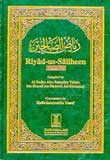Riyad Us-Saliheen (Gardens of the Righteous)

Chapter 117
Excellence of wearing white clothes and the permissibility of wearing red, green, yellow and black clothes made from Cotton, Linen but not Silk
Allah, the Exalted, says:
"O Children of ¢dam! We have bestowed raiment upon you to cover yourselves (screen your private parts) and as an adornment, and the raiment of righteousness, that is better.'' (7:26)
"And (Allah) has made for you garments to protect you from the heat (and cold), and coats of mail to protect you from your (mutual) violence.'' (16:81)
779. Ibn `Abbas (May Allah be pleased with them) reported: I heard Messenger of Allah (PBUH) saying, "Put on white clothes because they are the best; and use them for shrouding your dead.''
[At-Tirmidhi and Abu Dawud].
780. Samurah (May Allah be pleased with him) reported: Messenger of Allah (PBUH) said, 'Wear white clothes because they are the purest and they are closest to modesty; and shroud the dead in it.''
[An-Nasa'i and Al-Hakim].
Commentary: Both these Ahadith tell us that white clothes are fine and likeable and are especially recommended on Fridays and on all other occasions except on `Eid days where new clothes, if any, are recommended. The purity and beauty of this colour befits the dignity and honour of man.
781. Bara' (May Allah be pleased with him) reported: Messenger of Allah (PBUH) was of medium stature. I saw him wearing a red mantle. I have never seen anything more graceful than that.
[Al-Bukhari and Muslim].
Commentary: On the basis of this Hadith, some argue that red dress is also allowed to men. Imam An-Nawawi seems to hold the same view. However, many `Ulama' believe that the dress of Messenger of Allah (PBUH) was not all red but had red stripes. They, therefore, maintain that the red clothes which women wear are not permissible to men. Some `Ulama' think that a ruling on this issue will be on condition of space and time. If at some place disbelievers or women are fond of this colour, it will be banned for Muslim men because of its relevance to disbelief and womanishness. Yet, it will be allowed to Muslim men in a contrary situation. Opinions also exist that the indoor wear of red clothes is permissible to men but forbidden in public. To sum up, the red-coloured dress is not itself a taboo with regard to men. A ruling on it will be conditional in accordance with the situation. For example, in the Eastern society the red-coloured dress is usually worn by women and is peculiar to brides on the occasion of wedding. Men are, therefore, banned to wear it. Allah Alone has the true knowledge.
782. Abu Juhaifah Wahb bin `Abdullah (May Allah be pleased with him) reported: I saw the Prophet (PBUH) by Al-Abtah valley in Makkah, in a red tent made from tanned skin. Bilal brought him ablution water. Then Messenger of Allah (PBUH) came out wearing a red mantle; and I can still remember looking at whiteness of his shanks. So he made his ablution, and Bilal (PBUH) pronounced the call for prayer (Adhan). I kept following the movement of his (Bilal's) face to the right and to the left when he recited: `Come to the prayer; come to the success.' Then a spear was fixed (as a Sutrah) in front of Messenger of Allah (PBUH) who then stepped forward and led the prayer. Dogs and donkeys passed in front of him (beyond the spear) and no one prevented them from doing so.
[Al-Bukhari and Muslim].
Commentary: `Al-Abtah' is the name of a place which is also called the Muhassab valley. Lexically `Al-Abtah' means a sloping ground. Since it was the passage of rainy water owing to its downward slope, it came to be known by this name. Here the Prophet (PBUH) encamped in a tent.
This Hadith provides for wearing red-coloured clothes as mentioned in detail in the preceding Hadith. Second, it points out an issue concerning the ritual prayer. The worshipper should place something before him as a symbol of obstruction (Sutra) so that somebody who goes past him may not divert his attention. Yet, there is no harm if the passer is an animal.
783. Abu Rimthah Rifa`ah At-Taimi (May Allah be pleased with him) reported: I saw Messenger of Allah (PBUH) wearing two green garments.
[Abu Dawud and At-Tirmidhi].
Commentary: Here we see a provision for wearing green-coloured clothes.
784. Jabir (May Allah be pleased with him) reported: Messenger of Allah (PBUH) entered Makkah on the day of its conquest and he was wearing a black turban.
[Muslim].
785. Abu Sa`id `Amr bin Huraith (May Allah be pleased with him) reported: As if I am seeing Messenger of Allah (PBUH) wearing a black turban and both ends of it are falling over his shoulders.
[Muslim].
Another narration is: Messenger of Allah (PBUH) was delivering a Khutbah wearing a black turban.
Commentary: We conclude from this Hadith that one can also put on black-coloured dress, turban and covering. Muslim scholars have said that it is a desirable act Mustahab to wear a black turban after defeating the enemy.
786. `Aishah (May Allah be pleased with her) reported: The body of Messenger of Allah (PBUH) was shrouded in three white Yemeni cotton garments, among which was neither a gown nor a turban.
[Al-Bukhari and Muslim].
Commentary: The shroud of a dead body consists of three simple pieces of cloth to the exclusion of a turban, shirt and Izar. It is better for the shroud to be white.
787. `Aishah (May Allah be pleased with her) reported: One morning Messenger of Allah (PBUH) went out wearing a black blanket made of camel's or sheep's black hair with patterns of camels' bags upon it.
[Muslim].
Commentary: This Hadith tells us that one can wear a black woollen cloth with the woven image of an inanimate object.
788. Al-Mughirah bin Shu`bah (May Allah be pleased with him) reported: I was with Messenger of Allah (PBUH) in a journey one night, and he asked me, "Do you have any water with you?'' I said, "Yes.'' So he dismounted from his riding camel and walked away (to answer the call of nature) until he disappeared in the darkness. When he returned, I poured out some water from a vessel and he washed his face. He was wearing a long woollen cloak and could not take out his forearms from his sleeves, so he brought them out from below the cloak and then washed them, and then passed his (wet) hands over his head. I stretched out my hand to take off his Khuff (leather socks), but he said, "Leave them. I put them on after performing Wudu','' and he passed his (wet) hands over them.
[Al-Bukhari and Muslim].
Another narration is: Messenger of Allah (PBUH) was wearing a Syrian cloak with tight sleeves.
Another narration is: This incident took place during the battle of Tabuk.
Commentary: Here, too, we have justification for wearing woollen dress. In order to answer the call of nature, one is supposed to get out of people's sight. Instead of washing the feet while performing Wudu', one may simply pass wet hands over the socks or stockings if these have been worn after the performance of ablution. A non-travelling person is allowed this facility for twenty-four hours while in the case of a traveller, this period is extended to three days. However, in case of sexual impurity one must take full bath.
